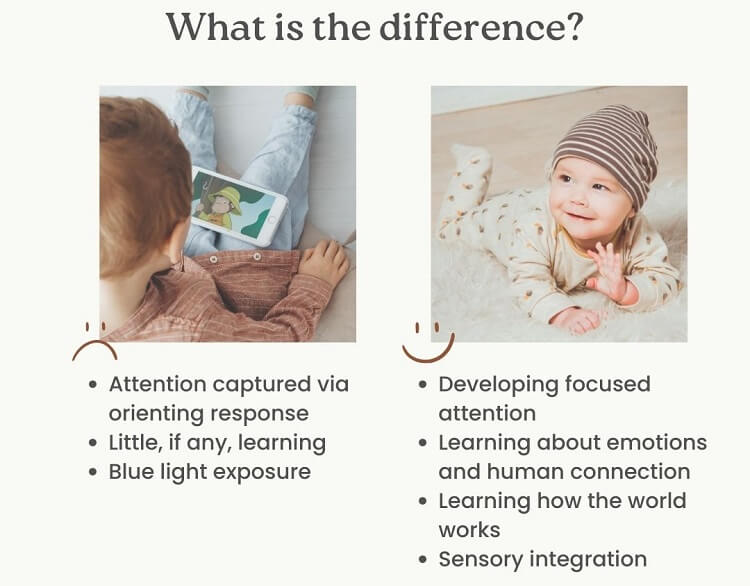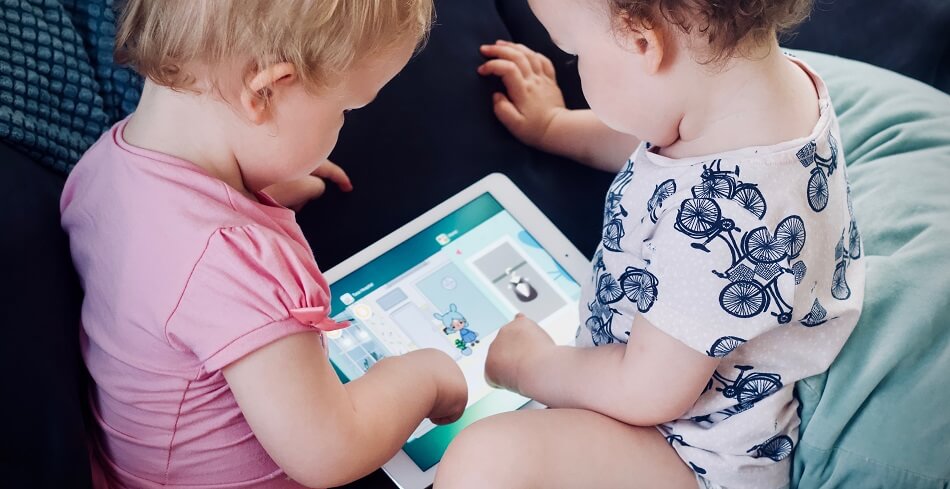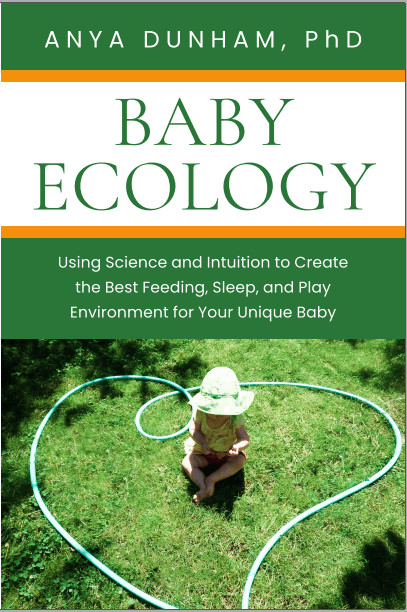Baby Ecology book is here! Learn more
Baby Ecology book is here!
- Home
- Baby activities
- Screen time for baby
- Why Babies Do Not Learn From Screens
Why babies do not learn from screens
by Anya Dunham, PhD
The video deficit phenomenon – or why babies do not learn from screens nearly as much as they do from real life – explained in under 5 minutes.

As you know, the American Academy of Pediatrics (AAP) recommends no screen time except for video-chatting for children under 18 months, and carefully chosen high-quality programming, watched with a parent, beyond 18 months. As of 2019, the World Health Organization recommended no screen time for children under 2 years old. (The science behind these recommendations.)
These recommendations stem, in part, from the "video deficit" phenomenon: the finding that babies and toddlers don't learn from screens nearly as much as they do from real life. But do you know why that is? Let's explore, using two hypothetical scenarios as our examples.
Why babies do not learn from screens
Let's compare two babies:
- Baby Ainsley is watching a kids' show on tablet
- Baby Brooke is watching real life around her, from her dad's arms at the park.
Are their experiences similar or different?
📌 Rapid movements and flashing lights on screen capture babies' and toddlers' attention involuntarily through orienting response: a reflex that quickly fixes their attention on new sights and sounds.1 Because of this, baby Ainsley's mind is firing "Something new! But what is it? Oh, and what's that? And where did that first thing go? Oh, wait, a flash!". Orienting response is an important mechanism behind early learning, but it must slowly, gradually give way to executive attention we know as focus.2,3 This process takes time and requires practice. Baby Brooke is watching people and events in a calm, real-life environment that is helping her build focused attention.
📌 Objects in real life follow the laws of physics. (Baby Brooke is watching her brother's soccer ball roll until it naturally stops.) Objects on screen often don't. (In Ainsley's show, the ball goes off screen and then appears again in the top corner, in an edited sequence.)
📌 Real life consistently gives babies opportunities to observe, and feel, a wide range of human emotions. (Baby Brooke is seeing a toddler crying and being comforted by his grandmother.) When emotions are displayed on screen in kids' shows, they are often exaggerated to a point of being unrecognizable; they are also disconnected from real life. (In baby Ainsley's show, the dancing fruit is now shedding tears that look like tiny blue circles going in different directions.)
📌 In real life, babies get a chance to engage multiple senses at once. Baby Brooke is seeing, hearing, smelling, and perhaps even safely petting, a neighbor's friendly dog – learning about animals while rich sensory input is integrated. Conversely, screen time doesn't provide coordinated sensory input.4-6 Baby Ainsley is seeing what is supposed to represent flowers, but they don't look like real flowers, and she cannot touch or smell them.
Which baby had a more 'educational' or 'quality' time?
Bottom line
Babies need human connection and benefit from opportunities to observe the real world unhurriedly, in a safe, predictable environment – not screens.
References
References
1. Anderson DR, Pempek TA (2005) Television and very young children. American Behavioral Scientist 48(5): 505-522
2. Posner MI, Rothbart MK, Voelker P (2016) Developing brain networks of attention. Current Opinion in Pediatrics 28(6): 720-724
3. Christakis DA et al (2004) Early television exposure and subsequent attentional problems in children. Pediatrics 113(4): 708-713
4. Haughton C, Aiken M, Cheevers C (2015) Cyber babies: the impact of emerging technology on the developing infant. Psychology 5(9): 504-518
5. Tierney AL, Nelson CA III (2009) Brain development and the role of experience in the early years. Zero Three 30(2): 9-13
6. Heffler KF et al. (2024) Early-life digital media experiences and development of atypical sensory processing. JAMA Pediatricts doi:10.1001/jamapediatrics.2023.5923
Using hundreds of scientific studies, Baby Ecology connects the dots to help you create the best environment for sleep, feeding, care, and play for your baby.
Warmly,
Anya





